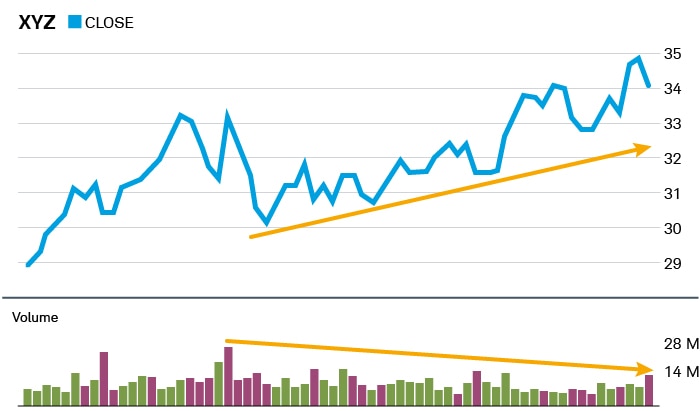What Kind of Daily Volume is Considered Good Enough for Easy Trading in the Stock Market
Stock price movements aren't always what they appear. Beneath the surface of a move higher or lower, trends may be forming—or fizzling into a reversal. That's why traders look for other indications of enthusiasm when they want to confirm or refute a price signal. Trading volume, which measures the number of shares traded during a particular time period, can help.
While swings in trading volume may not be enough on their own to reveal changes in a trend, they can give you a sense of how much strength there is behind a move. Here's how you can use volume indicators in your trading.
What traders look for
In short, above average and/or increasing trading volume can signal that traders are truly committed to a price move, which you can see in Chart 1 below, where the price and volume lines are both increasing. Contrariwise, below average and/or decreasing volume can signal a lack of enthusiasm, which you can see in Chart 2, where volume is declining even as the price continues to creep higher.

Source: Charles Schwab & Co.
Bullish signals from trading volume
Here are some common ways to use volume to confirm a bullish price move, as well as an example of how volume can undermine a price trend.
Upside breakout with above average volume
During uptrends and in sideways markets, a stock's price will occasionally run into a resistance level—a point where upward trends start to fizzle as selling pressure overcomes buying pressure. When a stock's price breaks through that level, the breakout is generally believed to be more significant if volume is high or above average. A breakout accompanied by low volume suggests enthusiasm for the move may be lacking.

Source: Charles Schwab & Co.
Uptrend accompanied by increasing volume
An uptrend paired with increasing and/or above average volume implies investor enthusiasm for that stock or asset is strong, which could lead to more buying and even higher prices.

Source: Charles Schwab & Co.
An uptrend with decreasing volume
An uptrend without increasing and/or above average volume suggests investor enthusiasm is limited. While the price could continue to rise, many traders who use volume analysis will nevertheless look for other candidates.

Source: Charles Schwab & Co.
Bearish signals from trading volume
Here are some common ways to use volume to confirm a bearish price move, as well as an example of how volume can undermine a price trend.
Downside breakout accompanied by heavy volume
During downtrends and in sideways markets, a stock's price will occasionally run into a support level, which is where downward trends tend to weaken as buying pressure overcomes selling pressure. When the price breaks below a support level, the breakdown is generally believed to be more significant if volume is high or above average. A breakout accompanied by low volume suggests enthusiasm is lacking.

Source: Charles Schwab & Co.
Downtrend accompanied by increasing volume
A downtrend accompanied by increasing and/or above average volume implies investors have doubts about the stock, which could lead to more selling and even lower prices.

Source: Charles Schwab & Co.
A downtrend with decreasing volume
A downtrend without increasing and/or above average volume implies investor concern is limited. While the stock's price may continue to fall, traders who use volume analysis may start to follow the stock and watch for signs of a pickup supported by increasing volume.

Source: Charles Schwab & Co.
As a rule of thumb, any price breakout or trend that is accompanied by above average volume could be considered more significant than price movements that are not.
Source: https://www.schwab.com/learn/story/trading-volume-as-market-indicator
0 Response to "What Kind of Daily Volume is Considered Good Enough for Easy Trading in the Stock Market"
Post a Comment